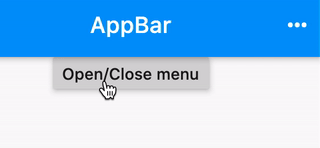How to open a PopupMenuButton?
Screenshot:

Full code:
class MyPage extends StatelessWidget {
final GlobalKey<PopupMenuButtonState<int>> _key = GlobalKey();
@override
Widget build(BuildContext context) {
return Scaffold(
appBar: AppBar(
actions: [
PopupMenuButton<int>(
key: _key,
itemBuilder: (context) {
return <PopupMenuEntry<int>>[
PopupMenuItem(child: Text('0'), value: 0),
PopupMenuItem(child: Text('1'), value: 1),
];
},
),
],
),
body: RaisedButton(
onPressed: () => _key.currentState.showButtonMenu(),
child: Text('Open/Close menu'),
),
);
}
}
I found a solution to your question. You can provide a child to PopupMenuButton which can be any Widget including a ListTile (see code below). Only problem is that the PopupMenu opens on the left side of the ListTile.
final popupMenu = new PopupMenuButton(
child: new ListTile(
title: new Text('Doge or lion?'),
trailing: const Icon(Icons.more_vert),
),
itemBuilder: (_) => <PopupMenuItem<String>>[
new PopupMenuItem<String>(
child: new Text('Doge'), value: 'Doge'),
new PopupMenuItem<String>(
child: new Text('Lion'), value: 'Lion'),
],
onSelected: _doSomething,
)
I think it would be better do it in this way, rather than showing a PopupMenuButton
void _showPopupMenu() async {
await showMenu(
context: context,
position: RelativeRect.fromLTRB(100, 100, 100, 100),
items: [
PopupMenuItem<String>(
child: const Text('Doge'), value: 'Doge'),
PopupMenuItem<String>(
child: const Text('Lion'), value: 'Lion'),
],
elevation: 8.0,
);
}
There will be times when you would want to display _showPopupMenu at the location where you pressed on the button Use GestureDetector for that
final tile = new ListTile(
title: new Text('Doge or lion?'),
trailing: GestureDetector(
onTapDown: (TapDownDetails details) {
_showPopupMenu(details.globalPosition);
},
child: Container(child: Text("Press Me")),
),
);
and then _showPopupMenu will be like
_showPopupMenu(Offset offset) async {
double left = offset.dx;
double top = offset.dy;
await showMenu(
context: context,
position: RelativeRect.fromLTRB(left, top, 0, 0),
items: [
...,
elevation: 8.0,
);
}
This works, but is inelegant (and has the same display problem as Rainer's solution above:
class _MyHomePageState extends State<MyHomePage> {
final GlobalKey _menuKey = GlobalKey();
@override
Widget build(BuildContext context) {
final button = PopupMenuButton(
key: _menuKey,
itemBuilder: (_) => const<PopupMenuItem<String>>[
PopupMenuItem<String>(
child: Text('Doge'), value: 'Doge'),
PopupMenuItem<String>(
child: Text('Lion'), value: 'Lion'),
],
onSelected: (_) {});
final tile =
ListTile(title: Text('Doge or lion?'), trailing: button, onTap: () {
// This is a hack because _PopupMenuButtonState is private.
dynamic state = _menuKey.currentState;
state.showButtonMenu();
});
return Scaffold(
body: Center(
child: tile,
),
);
}
}
I suspect what you're actually asking for is something like what is tracked by https://github.com/flutter/flutter/issues/254 or https://github.com/flutter/flutter/issues/8277 -- the ability to associated a label with a control and have the label be clickable -- and is a missing feature from the Flutter framework.